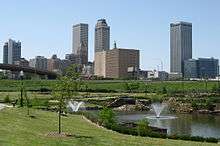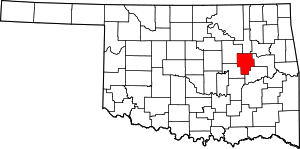Henryetta, Oklahoma
Henryetta is a city in Okmulgee County, Oklahoma, United States. The population was 5,927 at the 2010 census, down 9.6 percent from 6,096 at the 2000 census.[5]
Henryetta, Oklahoma | |
|---|---|
| Nickname(s): "Rodeo Cowboy Capital Of The World" | |
| Motto(s): "A legacy of legends, cowboys & heroes." | |
Location of Henryetta, Oklahoma | |
| Coordinates: 35°26′33″N 95°59′6″W | |
| Country | United States |
| State | Oklahoma |
| County | Okmulgee |
| Government | |
| • Type | Council-Manager |
| Area | |
| • Total | 6.65 sq mi (17.22 km2) |
| • Land | 6.61 sq mi (17.12 km2) |
| • Water | 0.04 sq mi (0.10 km2) |
| Elevation | 682 ft (208 m) |
| Population (2010) | |
| • Total | 5,927 |
| • Estimate (2019)[2] | 5,566 |
| • Density | 841.80/sq mi (325.05/km2) |
| Time zone | UTC-6 (Central (CST)) |
| • Summer (DST) | UTC-5 (CDT) |
| ZIP code | 74437 |
| Area code(s) | 539/918 |
| FIPS code | 40-33750[3] |
| GNIS feature ID | 1093675[4] |
| Website | http://cityofhenryetta.org/ |
History
Hugh Henry established a ranch on Creek Nation land in 1885. He soon found a deposit of coal, which he began using to fuel the forge at his ranch. Discovery of more coal deposits attracted several railroads to develop these mines. A settlement named Furrs grew up around the mines. The name changed to Henryetta when a post office opened on August 28, 1900.[6]
At statehood in 1907, Henryetta had 1,051 residents. The economy was based on agriculture, coal, natural gas and oil. In 1909, the area had fourteen coal mines, producing 65,000 tons per month. By 1910, the population had grown to 1,671. The town added a broom factory, several brick factories and a bottling plant during the 1920s.[6] In this era, Henryetta was a sundown town where African Americans were not allowed to enter after dark.[7]
Henryetta's manufacturing base continued to expand. Pittsburgh Plate Glass (PPG) built a plate glass window plant in Henryetta in 1929–30,[8] employing nine hundred people and claiming to be the largest west of the Mississippi River. The factory closed in 1974, but was purchased and refitted for making glass containers, and continues in operation by Anchor Glass Container.[8][9]
Eagle-Picher Company employed more than seven hundred people at its plant that extracted the rare metal germanium.[6] The plant has since closed and became a Superfund cleanup site.
Besides Anchor Glass, current employers include the international oilfield-services company Shawcor;[10] Henryetta Pallet, a regional wood pallet manufacturer;[11] and, G&H Decoy, a waterfowl decoy manufacturer since 1934.[12]
Geography
Henryetta is located at 35°26′33″N 95°59′6″W (35.442379, -95.985000).[13]
Henryetta is at the crossroads of Interstate 40, being a major east–west interstate highway through the south-central portion of the United States, and U.S. Route 75, being a major north–south highway currently extending from Noyes, Minnesota on the Canada–United States border south to Dallas, Texas.[14]
According to the United States Census Bureau, the city has a total area of 6.1 square miles (16 km2), of which, 6.0 square miles (16 km2) of it is land and 0.04 square miles (0.10 km2) of it (0.66%) is water.
Demographics
| Historical population | |||
|---|---|---|---|
| Census | Pop. | %± | |
| 1910 | 1,671 | — | |
| 1920 | 5,889 | 252.4% | |
| 1930 | 7,694 | 30.7% | |
| 1940 | 6,905 | −10.3% | |
| 1950 | 7,987 | 15.7% | |
| 1960 | 6,551 | −18.0% | |
| 1970 | 6,430 | −1.8% | |
| 1980 | 6,432 | 0.0% | |
| 1990 | 5,872 | −8.7% | |
| 2000 | 6,096 | 3.8% | |
| 2010 | 5,927 | −2.8% | |
| Est. 2019 | 5,566 | [2] | −6.1% |
| U.S. Decennial Census[15] | |||
As of the census[3] of 2000, there were 6,096 people, 2,460 households, and 1,589 families residing in the city. The population density was 1,009.8 people per square mile (389.7/km2). There were 2,844 housing units at an average density of 471.1 per square mile (181.8/km2). The racial makeup of the city was 79.69% White, 0.57% African American, 12.30% Native American, 0.33% Asian, 0.02% Pacific Islander, 0.79% from other races, and 6.30% from two or more races. Hispanic or Latino of any race were 2.20% of the population.
There were 2,460 households, out of which 14.8% had a female householder with no husband present, and 35.4% were non-families. 31.9% of all households were made up of individuals, and 17.3% had someone living alone who was 65 years of age or older. The average household size was 2.39 and the average family size was 3.00.
In the city, the population was spread out, with 25.9% under the age of 18, 8.3% from 18 to 24, 23.6% from 25 to 44, 22.5% from 45 to 64, and 19.7% who were 65 years of age or older. The median age was 39 years. For every 100 females, there were 86.3 males. For every 100 females age 18 and over, there were 80.1 males.
The median income for a household in the city was $20,115, and the median income for a family was $24,760. Males had a median income of $28,661 versus $14,268 for females. The per capita income for the city was $11,908. About 19.9% of families and 22.8% of the population were below the poverty line, including 29.8% of those under age 18 and 17.8% of those age 65 or over.
Government
Henryetta has a council-manager form of government with an elected mayor.[6]
Notable people
Henryetta is notable as the high school hometown of NFL Hall of Fame quarterback Troy Aikman.[16] Other famous former and current residents include actress Alice Ghostley (Bewitched, Grease, Designing Women), Broadway actor Jeremy Hays (The Phantom of The Opera, Les Misérables), as well as rodeo favorites Jim Shoulders and Terry Don West. It is the birthplace of Oklahoma Supreme Court Chief Justice Steven W. Taylor and Mark Ryal, former Major League Baseball player.
Events
Henryetta has two large annual rodeos, being the Jim Shoulders Spring Roundup Rodeo in June and the Living Legends Rodeo over Labor Day Weekend.[17]
Parks and recreation
Just south of town is Nichols Park, developed between 1938 and 1941 by the Civilian Conservation Corps and the National Park Service, which is over 300 acres in size, and includes the 17 acre Nichols Lake offering fishing opportunities.[18]
Jim Hall Lake, also known as Lake Henryetta, is 450 surface acres southeast of town. Amenities include boat ramps, docks, primitive campsites, picnic areas, and outdoor grills.[19]
Lake Eufaula, Oklahoma’s largest lake,[20] is to the east of town.[21]
Historic locations
The Henryetta Historical Museum is housed in what was the town's first schoolhouse, and later what was the town's first courthouse.[22]
The Henryetta Golf Course and Country Club was established in the 1920s. It is open year-round and usually does not require advance tee-time reservations.[23]
Both the Hugh Henry House on N. 3rd St., and Nichols Park located 1.9 miles south of the junction of Lake Rd. and Main St., are included on the National Register of Historic Places listings in Okmulgee County, Oklahoma.
Cultural
Henryetta was referenced as character Stevie Rae's hometown in P. C. Cast's book series, House of Night. Henryetta is mentioned in the King of the Hill episode "Harlottown" as Arlen's new city manager's prior town.
Henryetta's school teams were known for their unusual nickname, the "Mud Hens" (later "Hens" and "Fighting Hens"), until a student petition led to a name change (to "Knights") in 1989.[24]
References
| Wikimedia Commons has media related to Henryetta, Oklahoma. |
- "2019 U.S. Gazetteer Files". United States Census Bureau. Retrieved July 28, 2020.
- "Population and Housing Unit Estimates". United States Census Bureau. May 24, 2020. Retrieved May 27, 2020.
- "U.S. Census website". United States Census Bureau. Retrieved 2008-01-31.
- "US Board on Geographic Names". United States Geological Survey. 2007-10-25. Retrieved 2008-01-31.
- clr search.com Henryetta, Oklahoma Demographics
- Bamburg, Maxine. "Henryetta," Encyclopedia of Oklahoma History and Culture, Oklahoma Historical Society, Accessed July 22, 2015.
- "Black History Month Profile: Young Lived Thrills of Rodeo Circuit". Tulsa World. Tulsa, Oklahoma. February 28, 1996. p. 5 – via NewsBank.
During those days, Henryetta had a 'Sundown' law which meant that blacks could not be in the town after sun down. Young broke that law frequently.
- "Glass Manufacturing". Oklahoma Historical Society. Retrieved February 26, 2020.
- "Our Locations". Anchor Glass Container. Retrieved October 3, 2019.
- "Locations, Shawcor Inspection Services". Shawcor. Retrieved October 6, 2019.
- "Henryetta Pallet Co". HenryettaPallet.com. Retrieved October 6, 2019.
- "About Us". G&H Decoys Inc. Retrieved October 6, 2019.
- "US Gazetteer files: 2010, 2000, and 1990". United States Census Bureau. 2011-02-12. Retrieved 2011-04-23.
- "Henryetta, Oklahoma". Mapquest. Retrieved October 6, 2019.
- "Census of Population and Housing". Census.gov. Retrieved June 4, 2015.
- Jensen, Jeffry (2002) [1992]. Dawson, Dawn P (ed.). Great Athletes. 1 (Revised ed.). Salem Press. pp. 20–22. ISBN 1-58765-008-8.
- "Henryetta and Rodeos". Henryetta Chamber of Commerce. Retrieved October 3, 2019.
- "Visit Historic Nichols Park". City of Henryetta. Retrieved April 27, 2020.
- "Jim Hall Lake". TravelOK.com. Retrieved April 26, 2020.
- "Lake Eufaula". TravelOK.com. Retrieved April 3, 2020.
- "Henryetta, Oklahoma". Google Maps. Retrieved April 27, 2020.
- "DiscoverOK – Henryetta Territorial Museum". Henryetta Historical Museum. Retrieved October 3, 2019.
- "Henryetta Golf Course". HenryettaGolf.com. Retrieved October 6, 2019.
- Jimmie Tramel, "The Henryetta Hens: Alums loyal decades after mascot change", Tulsa World, June 29, 2010.

